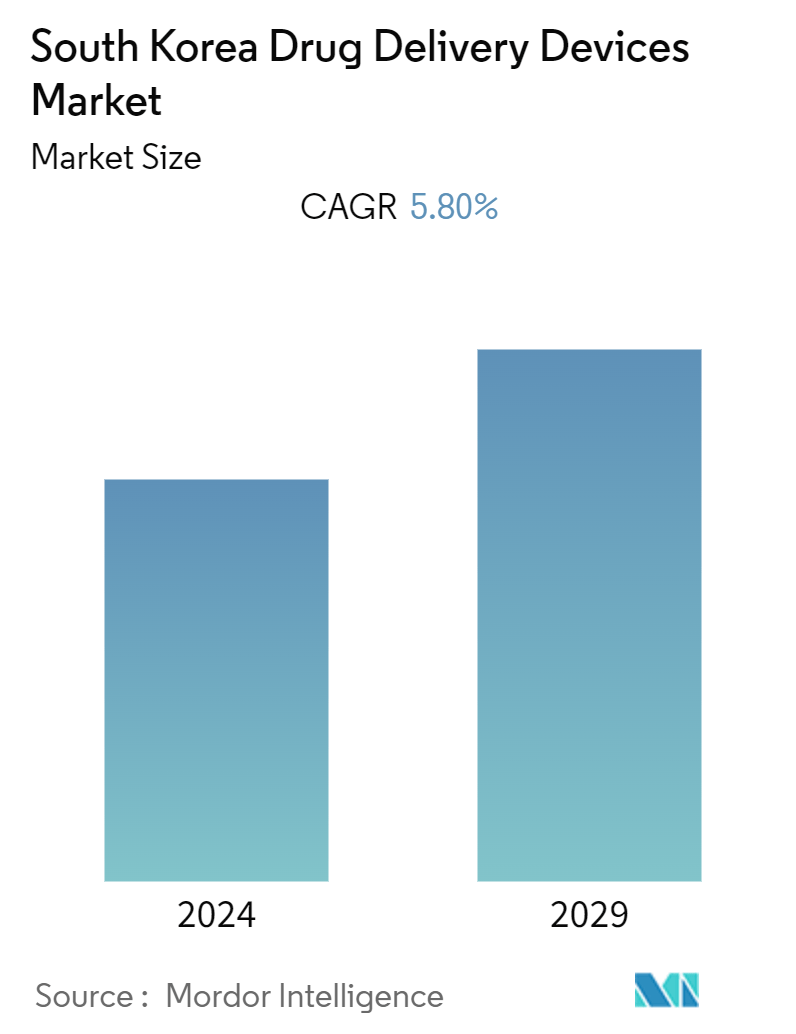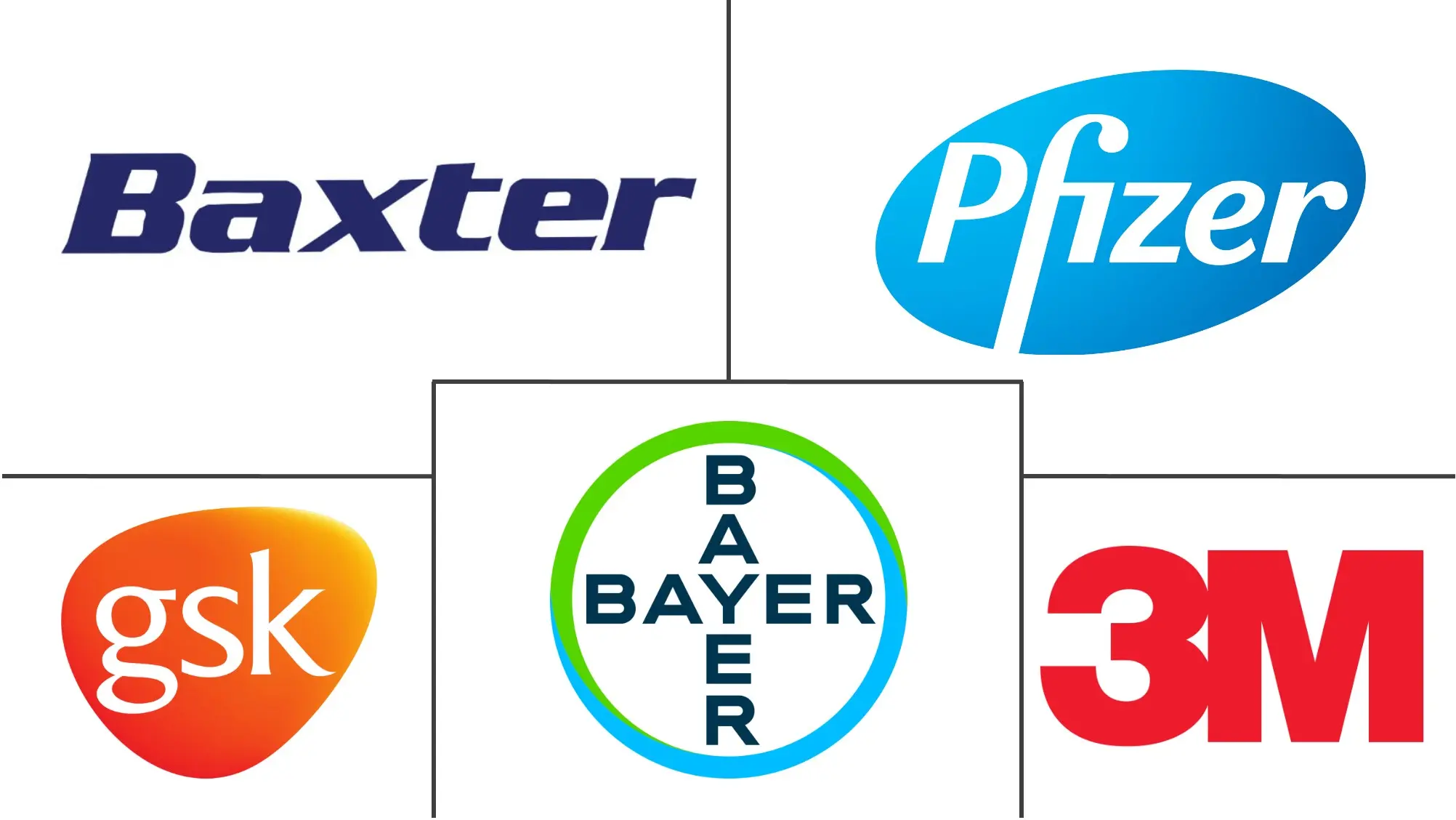Market Size of South Korea Drug Delivery Devices Industry

| Study Period | 2019 - 2029 |
| Base Year For Estimation | 2023 |
| Forecast Data Period | 2024 - 2029 |
| Historical Data Period | 2019 - 2022 |
| CAGR (2024 - 2029) | 5.80 % |
| Market Concentration | Medium |
Major Players
*Disclaimer: Major Players sorted in no particular order |
South Korea Drug Delivery Devices Market Analysis
The South Korea Drug Delivery Devices Market is expected to register a CAGR of 5.80% during the forecast period.
Drug delivery devices are specialized tools for delivering drugs or therapeutic agents via a specific route of administration. In South Korea, the demand for these devices has primarily increased due to the increasing prevalence of chronic diseases, such as cardiovascular diseases (CVD) and cancer. For example, according to an article published in PubMed Central in May 2022, 274,488 new cancer cases were anticipated to occur in Korea in 2022, with thyroid cancer predicted to be the most common type of cancer, followed by lung, colon, rectum, breast, and stomach cancer. Therefore, various types of drug delivery devices play an important role in targeted drug therapy for chronic diseases, thereby boosting the growth of the market.
Further, as the prevalence of chronic diseases such as diabetes, cardiovascular diseases, and respiratory disorders rises in South Korea, there is a growing need for efficient drug delivery mechanisms. Devices such as insulin pumps, inhalers, and injectors cater to these patient populations. For instance, according to the International Diabetes Federation, in 2022, 3.9 million people were expected to be diagnosed with diabetes in South Korea by 2030, and this number is projected to reach 3.9 million by 2045. Thus, the expected increase in diabetes cases in South Korea is anticipated to increase demand for drug delivery devices, thereby boosting market growth.
Market players are driving growth by developing new products, acquiring other companies, and forming strategic collaborations. These initiatives are expected to significantly impact the market during the forecast period. For instance, in March 2022, Futura Medical, a developer of transdermal DermaSys drug delivery technology, inked a licensing deal with Menarini Korea, a Menarini Group subsidiary. The agreement granted Menarini Korea exclusive rights to market Futura's gel-based Erectile Dysfunction (ED) treatment, MED3000, in South Korea.
Similarly, in November 2022, Medicox Co. Ltd signed an exclusive distribution contract with an oral drug delivery platform developer, ORAMED Pharmaceuticals, for distribution rights for ORAMED's oral insulin in South Korea.
High burdens of chronic diseases, notably diabetes and cancer, alongside ongoing product launches, are poised to drive market growth through the forecast period. Yet, rising infection risks and stringent regulatory hurdles for approval of drug delivery devices pose notable constraints.
South Korea Drug Delivery Devices Industry Segmentation
As per the scope of the report, drug delivery devices are specialized tools used for the delivery of a drug or therapeutic agent through a specific route of administration. The devices are used one or more times for medical treatments. These devices are also used for safe and effective drug delivery.
The South Korean drug delivery devices market is segmented by mode of administration and end user. By mode of administration, the market is segmented into injectable, topical, ocular, and other modes of administration. By end user, the market is segmented into hospitals, ambulatory surgical centers, and other end users.
The report offers the value (in USD) for the above segments.
| By Mode of Administration | |
| Injectable | |
| Topical | |
| Ocular | |
| Other Modes of Administration |
| By End User | |
| Hospitals | |
| Ambulatory Surgical Centers | |
| Other End Users |
South Korea Drug Delivery Devices Market Size Summary
The South Korean drug delivery devices market is poised for steady growth, driven by the increasing prevalence of chronic diseases such as cardiovascular conditions and cancer. The demand for these specialized tools, which facilitate the administration of drugs through specific routes, has been bolstered by the rising incidence of such diseases. The market's expansion is further supported by the development of innovative products and strategic collaborations among key players. The COVID-19 pandemic initially spurred significant investment in drug delivery technologies, as companies sought efficient methods to administer therapeutics. Although the focus has shifted back to pre-pandemic levels, the impact of these developments continues to influence market dynamics.
The injectable segment, in particular, is expected to experience rapid growth due to the convenience of self-injectors and the expanding biologics market. The increasing burden of chronic diseases, notably diabetes, is a major driver for the use of syringes and self-injectable devices. Additionally, topical drug delivery devices are gaining traction, supported by research highlighting their effectiveness and versatility in managing various conditions. The competitive landscape in South Korea is characterized by the presence of both international and local players, with companies actively pursuing partnerships and product innovations to capture market share. This competitive environment, coupled with a well-structured healthcare system, positions South Korea as a significant market for drug delivery devices.
South Korea Drug Delivery Devices Market Size - Table of Contents
-
1. MARKET DYNAMICS
-
1.1 Market Overview
-
1.2 Market Drivers
-
1.2.1 Increased Prevalence of Chronic Diseases
-
1.2.2 Requirement of Controlled Drug Release
-
-
1.3 Market Restraints
-
1.3.1 Risk of Infections During Usage and Stringent Regulatory Guidelines
-
-
1.4 Porter's Five Forces Analysis
-
1.4.1 Threat of New Entrants
-
1.4.2 Bargaining Power of Buyers/Consumers
-
1.4.3 Bargaining Power of Suppliers
-
1.4.4 Threat of Substitute Products
-
1.4.5 Intensity of Competitive Rivalry
-
-
-
2. MARKET SEGMENTATION (Market Size By Value - USD)
-
2.1 By Mode of Administration
-
2.1.1 Injectable
-
2.1.2 Topical
-
2.1.3 Ocular
-
2.1.4 Other Modes of Administration
-
-
2.2 By End User
-
2.2.1 Hospitals
-
2.2.2 Ambulatory Surgical Centers
-
2.2.3 Other End Users
-
-
South Korea Drug Delivery Devices Market Size FAQs
What is the current South Korea Drug Delivery Devices Market size?
The South Korea Drug Delivery Devices Market is projected to register a CAGR of 5.80% during the forecast period (2024-2029)
Who are the key players in South Korea Drug Delivery Devices Market?
Bayer, Baxter International, GlaxoSmithKline, 3M Company and Pfizer Inc. are the major companies operating in the South Korea Drug Delivery Devices Market.

